|
The Society
Historical Information
Photo & Map Collections
Exploring Brookline
Links
Program Archives
|
Brookline Village
 |
Brookline Village, 1905
Looking west toward Boylston St., Washington St. curves to the right by the Guild Building. The corner store in the foreground left is Heleotis Bros. Fruits and Ice Cream at 122 Washington St.
|
 |
Brookline Village, 1885
Looking west on lower Washington St. toward the start of Boylston St. Guild Block building in the center.
|
 |
Lower Washington St., North Side, December 23, 1915
Looking west. Foreground left: W.P. Whittemore Co., Hay and Grain, 92 Washington St.; Roeder's Lunch Dairy, in the corner building, 104 Washington St.
[Source: Olmsted]
|
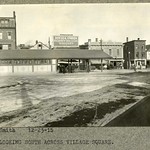 |
Washington St., North Side, December 23, 1915
Background buildings, left to right: Carl Astrom, photographer, #129; upper window of George Rozantes, fruit stand, #121; #115; Lyceum Hall Pharmacy, #113; Mack's Café, #107; David Lynch residence, small brick building, #105; Arthur Caulfield, insurance and real estate, #103.
[Source: Olmsted]
|
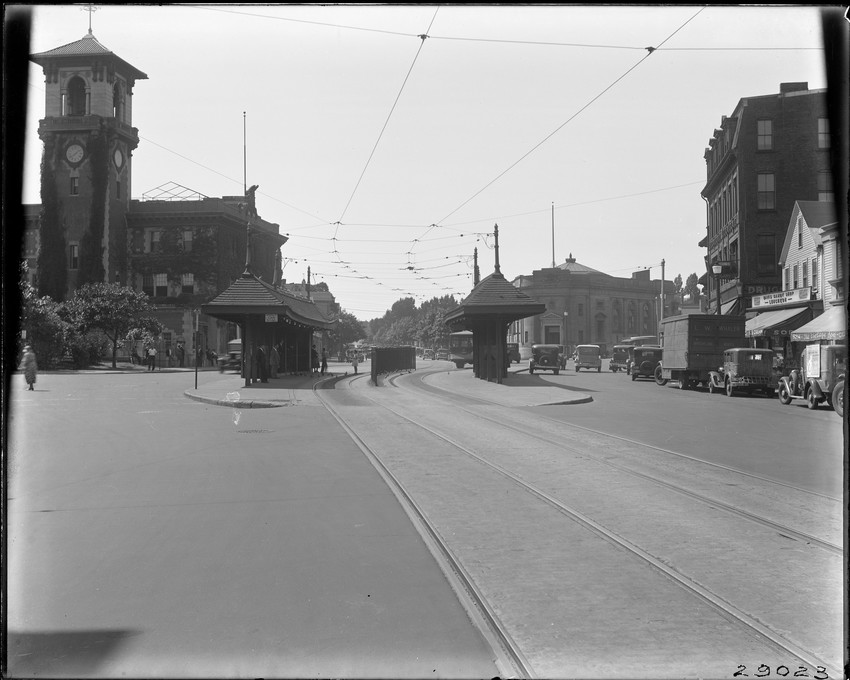 |
Lower Washington St., mid 1930s
This is one of three photos taken of this block. Looking west toward the start of Boylston St. From left to right:
- The fire house, still standing
- The Brookline Savings Bank, building still standing
- The tall brick building known as the “Sagamore” which housed Burns Drug Co. at 127 Washington St., visible on the right side
- The Davis Candy Shop at 121 Washington St.
- The van of Leslie W. Whalen, a Brookline mover
- A car advertising Brick Bradford, a science-fiction comic strip in Boston’s Daily Record newspaper
- Partial view of The Village Spa at 115 Washington St., run by the Rozantes family who lived upstairs above the store.
[Source: Historic New England]
|
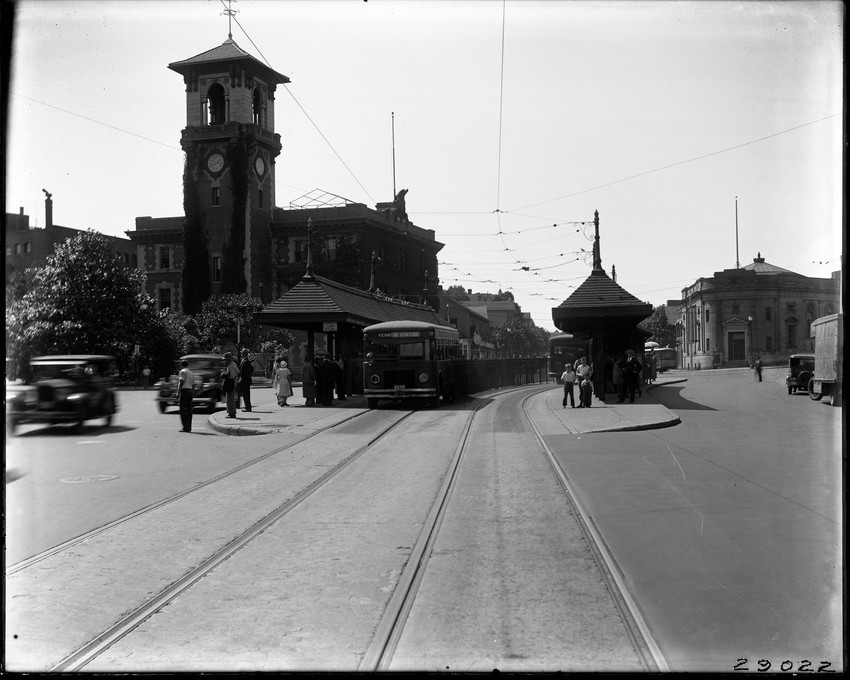 |
Lower Washington St., mid 1930s
Looking west on lower Washington St. toward the start of Boylston St. In the center of the photo, situated across High St. from the fire station, the Ford sign of T. C. Baker, a Ford dealership at 2 Boylston St., is visible. This is one of three photos taken of this block.
[Source: Historic New England]
|
 |
Village Transfer Station, circa 1911
On Lower Washington St., recently completed in September, 1909. On the left is Boylston St. looking west. The grocery store of Thomas F. McMahon is visible behind the left platform. The Sagamore Café, which closed in April 1912, and the drug store of T. E. Burns are visible behind the second station.
[Source: MBTA]
|
 |
Brookline Village, 1937
Looking east on lower Washington St. toward Boston. Parker Hill and N.E. Baptist Hospital upper right. Walnut St. on the right. Taken on 11/29/1937 by C. Parker, Brookline Engineering Dept.
|
 |
Brookline Village, 1937
Looking east on lower Washington St. toward Boston. Walnut St. on the right. Note scaffolding for the construction of the Brookline Theater on the left side of the street. All the buildings were raised in the 1960s as part of a large urban redevelopment program. Photo taken on 11/29/1937 by C. Parker, Brookline Engineering Dept.
|
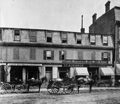 |
Brookline Village, circa 1875
This is a unique early photo of the section of Lower Washington St. that became known as “Russell’s Block”. From left to right:
- [145-147 Washington St.] Brown Brothers, Fruits and Vegetables, Provisions
- To the right of the door for the upstairs rooms is an unattributed sign advertising “Drain Pipe, Nails, Powder, Soft Lead, …. Hardware”
- [137-139 Washington St.] Thomas T. Robinson, Fine Groceries. He had recently taken over the business of Marshall Russell whose sign still remains in the photo.
[Source: Brookline Public Library]
|
 |
Relocation of the Village Brook, circa 1893
Looking east on lower Washington St. toward Huntington Ave, Boston. Walnut St. feeding in on the right. Note that this is one of two different views taken at the same time.
Tom Condon, Sr. Civil Engineer for Brookline writes:
The work shown is part of the relocation of the outlet of the Village Brook. …(in the pile of lumber in the background you can see a piece of the curved falsework used
to hold the brick arch until the cement mortar set.). Leverett Pond was created from the Muddy River marsh located just south of Washington Street by installing a stop plank manhole (in effect an adjustable height dam) in the new culvert under Washington Street. This stop plank manhole was necessary to hold back the pond since the Charles and therefore the Muddy Rivers were still tidal at that time. Presumably, Alexis French (who was both Olmsted's engineer and the Town Engineer) determined that more flow into this new pond was necessary. To provide this additional flow, the Village Brook which flows alongside what is now the MBTA "D" line was diverted into the culvert shown under construction. The culvert runs east down Washington Street, crosses Walnut Street, runs down Morss Avenue (now discontinued), across Pond Avenue and into Leverett Pond.
|
 |
Relocation of the Village Brook, circa 1893
Lower Washington St. going toward Boston angling to the left rear. Note that this is one of two different views taken at the same time. From right to left, looking at the south side of Washington St.:
- Sing Lee, laundry, #136
- John Barthelmes, hairdresser, #134
- Frank T. Fay, newsdealer, cigars and tobacco, #128
- William Frawley, custom shoemaker (note picture of boot on sign), #126
- Luigi Barba (aka Louis Barbour and Louis Barber), fruit, #126
On the left of the photo is the awning of Thomas S. Brown & Co., provisions, at #145 Washington St. Tom Condon, Sr. Civil Engineer for Brookline writes:
The work shown is part of the relocation of the outlet of the Village Brook. …(in the pile of lumber in the background you can see a piece of the curved falsework used
to hold the brick arch until the cement mortar set.). Leverett Pond was created from the Muddy River marsh located just south of Washington Street by installing a stop plank manhole (in effect an adjustable height dam) in the new culvert under Washington Street. This stop plank manhole was necessary to hold back the pond since the Charles and therefore the Muddy Rivers were still tidal at that time. Presumably, Alexis French (who was both Olmsted's engineer and the Town Engineer) determined that more flow into this new pond was necessary. To provide this additional flow, the Village Brook which flows alongside what is now the MBTA "D" line was diverted into the culvert shown under construction. The culvert runs east down Washington Street, crosses Walnut Street, runs down Morss Avenue (now discontinued), across Pond Avenue and into Leverett Pond.
[Source: Digital Commonwealth]
|
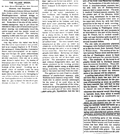 |
Relocation of the Village Brook, February, 23, 1894
Tom Condon, Sr. Civil Engineer for Brookline writes:
The work shown is part of the relocation of the outlet of the Village Brook. …(in the pile of lumber in the background you can see a piece of the curved falsework used
to hold the brick arch until the cement mortar set.). Leverett Pond was created from the Muddy River marsh located just south of Washington Street by installing a stop plank manhole (in effect an adjustable height dam) in the new culvert under Washington Street. This stop plank manhole was necessary to hold back the pond since the Charles and therefore the Muddy Rivers were still tidal at that time. Presumably, Alexis French (who was both Olmsted's engineer and the Town Engineer) determined that more flow into this new pond was necessary. To provide this additional flow, the Village Brook which flows alongside what is now the MBTA "D" line was diverted into the culvert shown under construction. The culvert runs east down Washington Street, crosses Walnut Street, runs down Morss Avenue (now discontinued), across Pond Avenue and into Leverett Pond.
|
 |
Lower Washington St. August, 1933
Looking east from the Village Square
[Source: Leo Sullivan]
|
 |
Sing Lee Chinese Laundry, Lower Washington St., circa 1891
Just east of the intersection of High St. and Boylston, next to Hose House #1. Torn down before 1908 for the construction of the present day firehouse. Orignally numbered 66 before renumbering of Washington St.
1) Note the "Employment Office" sign by the entrance to the stairs next door at #68. This was likely the office of Mrs. Benjamin Hill. Brokers like this were often the source of servants for the wealthy households of Brookline.
2) Note the "Board Rooms" sign on the second floor. Listed in the city directory as boarders at that address are Thomas Steward, hairdresser and Joseph Hartnett, carriage painter, who worked at Michael Quinlan’s carriage factory one block away at the southwest corner of High St. and Boylston St.
3) Note the "Ladies Pompadours Cut and Curled" sign to the left at the hair salon next door.
|
 |
Hose #1 House, Lower Washington St., Brookline Village, circa 1905
Formerly Good Intent Hose Company. Note mural in middle of façade.
|
 |
South Side, Lower Washington St., 1905
The stores are bedecked with banners celebrating the bicentennial These buildings were all demolished in 1907-1908 and the current fire station was opened on this site in 1909.
[Source: Digital Commonwealth]
|
 |
Lower Washington St., Brookline Village, circa 1905
The businesses viewed here, along the south side of Lower Washington St., were simultaneously sited at this location from 1904 - 1906. All the structures in this photo were demolished in 1907-1908 to make way for the new fire station which opened in 1909 and remains in use today. Note the man with his wheeled bucket, center photo, presumably scooping up horse droppings. Viewed from left to right:
- The business with the partial view of an awning is at the corner with Walnut St., the last building in this row. The best estimation is that it is the store of James Heleotis and John Sigalos Co., fruit [1904-1906]. The awning appears to advertise "Ice Cream Sodas" mirroring the sign at the corner entranceway visible in other photos.
- An enigmatic sign over the alleyway that seems to advertise a shooting gallery. This is currently unidentified.
- By the delivery wagon at #126 Washington St. are William Frawley, shoemaker [1889-1907]; and a bootblack, either W. L. Jacklin [1904] or Cromwell Felton [1905-1907].
- C. E. Riley, Cigars at #128 Washington St. [1900-1907]
- The awning at 134 Washington St. George W. Rix, Provisions and Transfer Market [1904-1907]
- Sing Lee, laundry, which was at #136 Washington St. for over 20 years [1883-1907]
- Hose House #1 and Chemical Engine #1 at #140 Washington St.
- P. J. Burns, Horse Shoe Forge at #144 Washington St. [1897-1907]
- Also at 144 Washington St. there remains a sign for R. Woodward who had a horse-shoeing business there from the 1860s until his death in 1892
- J. H. Pineo, carpenter and builder at 4 High St. (visible at corner of Washington St) [1901-1907]
|
 |
P. J. Burns, Horse Shoeing, Brookline Village, 1905
South side of Lower Washington St., #144, corner High St. Hose House 1 is partially visible on the left. Right rear, #4 High St. is partially visible. The fire station is showing banners for the 1905 bicentennial. These buildings were all demolished in 1907-1908 and the current fire station was opened on this site in 1909.
[Source: Digital Commonwealth]
|
 |
Memorial Day, 1923; Lower Washington St., Brookline Village
The Stephen F. Rutledge V.F.W Post #864. P. H. Tonra, Commander. Lower Washington St., Brookline Village. Stores are no longer standing. Current fire house visible, right rear. Edward Moloney is standing under the "JT Driscoll Plumbing" sign, he is the one in a hat instead of a helmet.
|
|